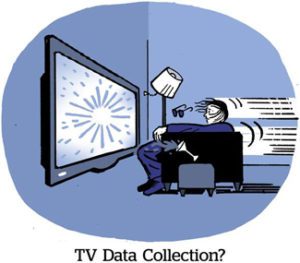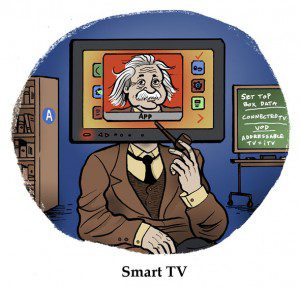TV original equipment manufacturers (OEMs) found a gold mine where the worlds of tech and content collide: connected TV advertising.
As smart TV adoption tapered off, OEMs had to get creative. The advent of streaming through those internet-connected TVs, and the inventory fragmentation that followed, gave OEMs an opening to break into advertising.
LG, Samsung and VIZIO are all TV hardware businesses that have ramped up their advertising businesses in recent years.
Ad sales is “high margin activity, relative to the low margin hardware business,” said Brian Wieser, global president of business intelligence at GroupM.
The reason the hardware biz is low margin isn’t solely due to aggressive competition but because, like any business, it needs to improve growth and profitability. “The same thing you made last year needs to be some percentage cheaper and some percentage better,” Wieser said.
With constraints on how much the physical TV screen can change, barring another massive technological advancement, “the profitability of the legacy business doesn’t necessarily improve,” he said. The next logical progression is monetizing what TVs can achieve as a premium “portal of content”: advertising.
It’s why TV manufacturers like LG and VIZIO are logging much higher revenue growth from ad sales than hardware. Roku, which makes devices like smart remotes (albeit no TVs) and an operating system that runs in many TVs, attributes most of its 2021 growth to advertising, having completely switched from a device-driven to an ad-driven business.
Going into advertising is appealing because the potential of ads is literally infinite – “you sell a TV once, but you can sell ads on it indefinitely,” said Jim Spaeth, partner at media consultancy Sequent Partners. “It’s a steady stream of revenue.”
It makes perfect sense for legacy TV businesses to break into advertising. But what about the other way around?
Benefits of hardware
The combination of TV hardware and an ad business is so winning, it’s even making advertising companies go into hardware.
Amazon went into TV hardware with its Fire TV, launched last year. Roku recently ran a focus group polling users about the idea of going into manufacturing (though it told investors not to read too much into its research).
Advertising, including the underlying software involved, is more profitable than hardware.
But even if hardware sales don’t bring in as much profit, the two pieces of the business go hand in hand to yield the most control over inventory, which means higher ROI. The less a company has to rely on intermediaries to provide the physical TV model or the operating system that pieces inventory and data together, the more profit a company can pocket for itself.
When content is built into devices themselves, companies can also amass much more user data, which can be sold or used to guide more successful media campaigns. Automated Content Recognition (ACR) data, in particular, can track everything a person watches on a TV, giving companies a rare, holistic picture of viewing behavior.
CEO of LG Ads Solutions Raghu Kodige called VIZIO a good “case study” into what that looks like. VIZIO first tried to IPO in 2015, the same year it built a business division around the use and sale of ACR data. Now, most of its revenue comes from ACR data and ad sales rather than hardware margins. It could be why the company merged together VIZIO Ads and Inscape, its ACR subsidiary, into the same business unit in 2020.
While it doesn’t sell its ACR data, LG Ads also claims the best of both worlds. Because it comes preloaded with content built into its devices, it can parcel up audience segments available to advertisers across all apps, optimizing its inventory. Not to mention it owns the marketing gold mine that is a smart TV’s home screen.
TV manufacturers can also optimize the consumer experience. Centralizing inventory can give companies insight into campaign performance, which in turn can mitigate the pet peeves plaguing streaming audiences, particularly overfrequency, Spaeth said. From a more technical perspective, Kodige also pointed out that third-party hardware might not have the right specs for a given OS, creating a subpar viewing experience.
Hardware beats software in TVs: “Software is commoditized,” GroupM’s Wieser said. Everyone knows if their TV is a Samsung or a VIZIO, but chances are they couldn’t name the OS behind the scenes.
Would content aggregators and software-first companies (like Roku) benefit from tacking on proprietary TV models to their business strategy? While Kodige admits that hardware is a “loss leader,” Wieser says enough investment can make it happen. “The best way to make a billion dollars is to spend two billion,” he said.
But the path isn’t nearly so straightforward.
The cons
Making a TV isn’t hard. Making a profitable TV is hard.
Compared with software, content and ad sales, hardware introduces entirely different capital costs and retail relationships – not to mention a fresh batch of competition.
Both Spaeth and Wieser agree that if Roku were to start making TVs, for example, it could make rivals out of new hardware-plus-ads competitors like LG and Samsung. According to Kodige, LG would welcome new competition with open arms, but the claim evokes the imagery of holding hands with brass knuckles. (Just look at all the alternate TV measurement providers racing to market.)
For a company to sell ads and hardware, there needs to be a combined promise of profitability and a better customer experience, or it’s not worth it. When push comes to shove, a better go-to-market strategy will crush better technology every time, Wieser said. It’s like getting married – if you’re not 100% sure it’ll work, steer clear.
If a content or software company is considering TV hardware as an ancillary business strategy, it needs to consider a lot of new questions: How quickly can the TVs be distributed to customers? Will the hardware produce a walled garden? Will scale be limited to households that buy the set? Will it siphon off too much investment from other endeavors? Does the move bolster or detract from the company’s core vision?
Companies know how to answer those questions better than investors ever will, Wieser added. The move could work for a company that centers itself around device production and quality (and has access to big capital), Spaeth said. But for software-first companies like Roku that are primarily content providers, “Frankly, I don’t see it,” he said.
Wieser points out that, because of its scale and ability to monetize inventory, Roku’s OS, combined with its original content, already gives the company full throttle on “a good chunk” of its inventory. For a software-centric company like Roku, the “ideal world” would be to “never have any hardware at all,” he said.
Which may be why, even as its Fire Stick competitor Amazon went into TV manufacturing last year, Roku denied a rumor earlier this year that it’s considering manufacturing TVs, very likely because it reached the same conclusions to those questions.



















